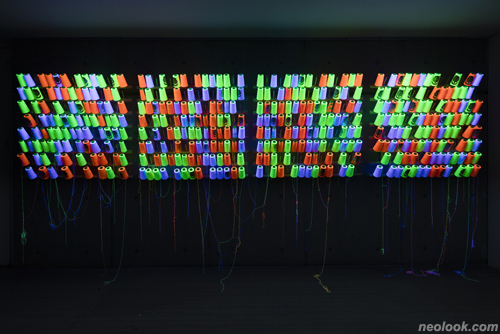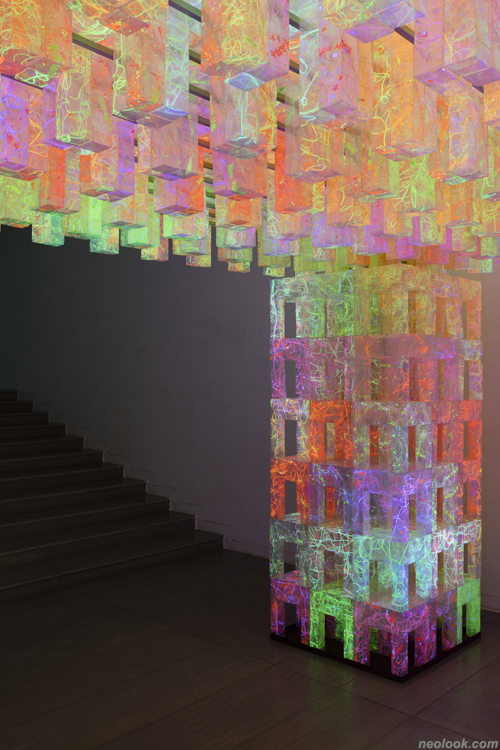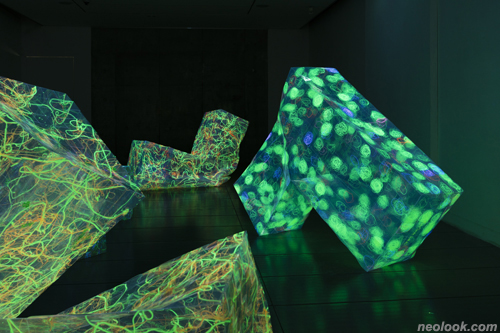- ● homepage
- ● archives
- ● restoration
- ● books
- ● big banners
- ● post board
- ■ neo's search
- ■ about us
- ■ 게재방법 안내
- 개인정보처리방침

- [email protected]
- Tel. 02_335_7922
- Fax. 02_335_7929
- 10:00am~04:30pm
- 월요일~금요일
- 3/3(월) 대체공휴일

실과 빛-관계의 시작 Thread and Light–The Beginning of Relationship
이은숙展 / LEEEUNSOOK / 李恩淑 / installation 2016_0312 ▶ 2016_0619 / 월요일 휴관
● 위 이미지를 클릭하면 네오룩 아카이브 Vol.20130223d | 이은숙展으로 갑니다.
초대일시 / 2016_0312_토요일_04:00pm
관람료 / 성인 3,000원 / 학생,단체 2,000원
관람시간 / 11:00am~06:00pm / 일요일_01:00pm~06:00pm / 월요일 휴관
블루메미술관(BMOCA) BLUME MUSEUM OF CONTEMPORARY ART, BMOCA 경기도 파주시 탄현면 법흥리 헤이리마을길 59-30(1652-140번지) Tel. +82.31.944.6324 www.bmoca.or.kr
실로 지은 집 - 관계 ● 블루메미술관은 '미술관 경험(Museum Experience)'에 대한 연구를 지속해가며 올 한해 '관계성'이라는 키워드에 주목하고자 한다. 미술관이라는 시공간안에서 새로이 형성되는, 환기되는, 또는 기억되는 여러 형태의 '관계'에 관한 이야기들을 전시화하는 것이다. ● 그 첫번째로 중견작가 이은숙의 『실과 빛-관계의 시작』展은 관계의 거리와 크기에 대해 생각하게 한다. 그가 십여년간 천착해온 작업의 주제는 가족과 남북관계이다. 하나는 작고 다른 한가지는 크다. 가족은 거리로 보자면 나에게 가장 가까운 것이고 국가는 삶의 단위로 보자면 추상적이라 할 만큼 먼 관계이다. 그러나 이은숙 작가에게 이 둘은 거의 같은 거리에 있고 같은 크기를 지닌다.

- 이은숙_실풀이_형광실, 블랙라이트, 실패_각 12×7×7cm×500_2016
그녀의 가족은 이산가족이다. 한국전쟁시 월남한 작가의 아버지는 북에 가족을 두고 온 실향민이었고 생전에 북에 남겨진 자녀들을 만나보지 못하고 돌아가셨다. 작가에게 남과 북이라는 분단국가의 관계는 곧 아픔이 있는 가족사로 이어지는 거시적인 동시에 미시적이고, 역사인 동시에 현재적이고 개인적인 것이다. 지금도 전쟁으로 인해 난민이 되어 흩어져 고통받고 있는 가족들처럼 말이다. 그리하여 그는 통일의 상징인 베를린 장벽앞에 한국 이산가족 5천명의 이름이 적힌 분단의 벽을 세우기도 하고, 베를린의 남북대사관을 실로 잇는 최근의 퍼포먼스 등을 통해 분단상태에 있는 국가 그리고 가족의 아픔을 치유하고 극복하고자 했다. 그에게 관계란 가장 작고 가까운 것이다가 동시에 한없이 커지고 통제할 수 없을 만큼 멀어지기도 하는 너비와 길이를 지닌 것이다.

- 이은숙_소통의 의자_폴리에스터, 형광실, 실크스크린, 블랙라이트_340×525×525cm_2014_부분
이번 전시에서 그는 다시 가족이라는 주제를 풀어낸다. 가장 작은 단위의 인간관계 안에 너무도 다양한 이야기들과 희로애락의 감정들이 담겨있는 것을 그는 형광실을 풀어내 만든 투명상자들에 담아왔다. 그 시작과 끝을 알 수 있을 듯 한 올로 풀려있거나 또는 복잡하게 층층이 얽혀있는 실의 모습과 성질을 투명한 사각의 형태에 담아내며 그는 맺거나 풀어야 할 관계의 여러 양태들을 이야기하는 듯하다. ● 실패에 감겨있는 500여개의 실들로 만들어진 「실풀이」라는 작품에서 실이 막 풀리기 시작한 그 한 올의 시작점이 주는 그 명쾌함, 동시에 실이 실패에서 풀려 나오는 순간 다시 스스로 또는 다른 무언가와 엉키게 마련인 그 복잡다단함은 하나의 언어로 정의하기 힘든 인간 관계의 여러 모습들을 대변하고 있다. 주로 기하학적 형태의 투명상자들을 사용하던 그가 마치 반형태(Anti-Form)들처럼 부드럽게 누워있는 상자들을 실험한 「ㄴ ㅏ, ㄴ ㅓ」라는 작품은 하나의 고정된 수직적 형태로 영원히 지탱될 수 없는 관계의 연약함과 예측불가능성과 같은 비정형의 성질들을 읽어보게 한다. 블랙라이트에 반응하는 그 형광빛들은 바쁜 일상의 삶에 가려져 잘 보이지 않는 관계맺기의 본질을 이야기하는 듯 하다.

- 이은숙_소통의 의자_폴리에스터, 형광실, 실크스크린, 블랙라이트_340×525×525cm_2014
이은숙 작가의 작품들이 비단 사람사이의 관계를 추상적으로 재현하고만 있는 것은 아니다. 여럿이 앉을 수 있는 의자를 만들어 관객이 쉬어갈 공간을 만들고 그 공간이 주는 시간안에서 서로를 관찰하거나, 말을 건네거나, 또는 서로 같은 공간을 점유하고 있다는 느낌만으로도 아주 작고 헐거운 형태의 관계가 성립될 수 있음을 보여주는 일종의 관객참여형의 작품들도 만들고 있다. 「소통의 의자」라는 제목으로 수많은 사람들이 오가는 홍콩의 한 광장에 설치되었던 이 작품이 그러하다. 사람들이 직접 앉을 수 있는 의자부분은 없지만 스툴과 같은 의자형태의 유닛 600여개가 모여 아치형의 건축적 구조물을 만들어내는 형태로 미술관 전시장안에 들어오게 된 이 작품은 어둠 가운데 빛을 뿜는 거대한 입체구조물이 만들어내는 공간안에서 함께 공유하게 되는 특정한 신체적 경험이 서로 완벽한 타인으로 만나는 관객들에게 아주 작고 짧은 순간이지만 함께함에 대해 생각해볼 수 있게 하는 실마리를 제공한다. ● 이 전시를 위해 그는 지역 청소년들과 사전워크숍을 진행하며 누가 무엇이 그들을 힘들고 어렵게 만드는지 그들의 이야기를 들어주며 그들이 남긴 이야기를 작품에 담기도 하였다. 그에게 작품은 관계 안에서 만들어지는 것이다. 하나의 작품을 사이에 두고 만나게 되는 사람 사이의 작은 이야기, 봄볕 작은 씨앗처럼 한 올 실같이 사소하고 가는 빛처럼 약해보이는 그 대화의 시작점에서 관계의 집이 지어지기 시작한다. 이런 집을 짓기 위한 시간과 공간을 펼쳐놓은 곳이 미술관 공간이고 이 안에서 작가는 대화의 실을 잣고 이야기와 관계의 방을 만들어나간다. ■ 블루메미술관

- 이은숙_ㄴ ㅏ ㄴ ㅓ (나,너)_폴리에스터, 형광실, 실크스크린, 블랙라이트_150×150×55cm_2016
House Built with Thread – Relationship ● The Blume Museum of Contemporary Art (BMOCA) will examine the keyword "relationship" while continuing its study on the theme of "museum experience." The term "relationship" here refers to how stories pertaining to a wide variety of human relationships that are formed, recollected, or remembered in the space and time of the museum are exhibited. ● 『Thread and Light – The Beginning of Relationship』, the first exhibition of its kind by an established artist in Korea, EunSook Lee, brings viewers to the distance and scale of such a relationship. The themes she has delved in for about ten years involve family and North and South relations. One may be considered trifle while another is considered grand. The former is close while the latter is either abstract or distant. To Lee, however, both are at the same distance and of the same size. ● Lee's family is one of many that had been torn apart: her father had defected to the South from the North during the Korean War, leaving his family in North Korea. During his lifetime he was unable to see his children again in North Korea. From the artist's point of view, the relationship between the divided North and South Koreas is simultaneously present, individual, and both macroscopic and microscopic as numerous families are still presently dispersed and suffering from the war. As such, Lee set up the wall of division on which the names of 5,000 separated Korean families were written in front of the Berlin Wall as a symbol of unification and tried to overcome the pain of the country and families that are in a separated state through a recent performance that links the South Korean Embassy to the North Korean Embassy in Berlin with thread. To the artist, a relationship is something small and intimate and is considered to have a scope and length that are too far apart to control. ● In this exhibition Lee once again brings the theme of family into the spotlight. She has contained stories of the great diversity found in human relationships and emotions such as joy, anger, sorrow, and pleasure in transparent boxes made of fluorescent spools of thread. She holds aspects and traits of thread that is unraveled in a strand whose beginning and end seem known and thread that is intricately tangled inside of transparent squares. She seems to be describing the diverse aspects of the relationships to be concluded or unraveled. ● In 「Untie a String」, a work made up of approximately 500 reels of thread, clarity deriving from a single strand that is just about to unwind and intricacy stemming from a strand that is again tangled with something else as soon as it is unwound from the reel seem to stand for diverse aspects of human relationships that are hard to define in one word. She experiments with soft boxes like anti-form in 「ㄴㅏㄴㅓ」, deviating from the geometrical transparent boxes she usually uses. Some traits such as unpredictability and the frailty of the relationship that cannot be permanently maintained are sensed in the structure's soft form against the fixed vertical shape. The fluorescent light reacting with the black light seems to be alluding to the nature of entering into a relationship that is often invisible and concealed by hectic routines. ● Abstract representations of the relationships among people are not the only things that comprise Lee's work. She has also worked on viewer participatory pieces showing how a loosely-knit relationship can be established just by making chairs on which many viewers can sit and take a rest, observing each other in the time the area offers, and speaking to each other with the sentiment that we are occupying the same space. An example is 「Chair of Understanding」, a work installed in a square in Hong Kong. In this work on display at the indoor museum space are about 600 stool-shaped units forming an arch-like architectural structure. In this work the specific physical experience viewers share within the space of the colossal three-dimensional structure provides viewers who are strangers with one another with an opportunity to ponder "being together" even if just for a moment. ● For this exhibition Lee conducted a preliminary workshop for local teenagers. She originally took the motif of her work from what they had said and who or what made their lives difficult. To the artist, work is something that is created within a relationship. A house of relations is built with stories from the people we meet through her work and at a starting point of conversations that looks as insignificant as a thin strand of thread and as feeble as a thin ray of light. The museum space is a place where the time and space required to build such a house are arranged and it is here that she spins a thread of conversation and makes a room of relationships. ■ BMOCA
Vol.20160312b | 이은숙展 / LEEEUNSOOK / 李恩淑 / installation

